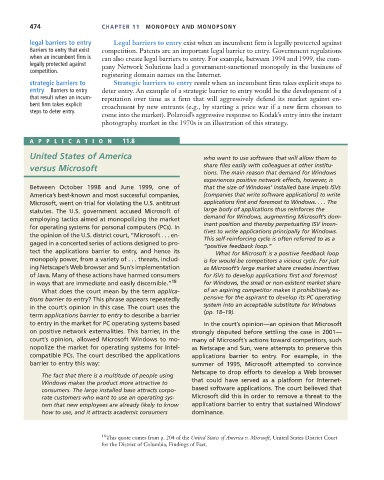Page 500 - Microeconomics, Fourth Edition
P. 500
c11monopolyandmonopsony.qxd 7/14/10 7:58 PM Page 474
474 CHAPTER 11 MONOPOLY AND MONOPSONY
legal barriers to entry Legal barriers to entry exist when an incumbent firm is legally protected against
Barriers to entry that exist competition. Patents are an important legal barrier to entry. Government regulations
when an incumbent firm is can also create legal barriers to entry. For example, between 1994 and 1999, the com-
legally protected against pany Network Solutions had a government-sanctioned monopoly in the business of
competition.
registering domain names on the Internet.
strategic barriers to Strategic barriers to entry result when an incumbent firm takes explicit steps to
entry Barriers to entry deter entry. An example of a strategic barrier to entry would be the development of a
that result when an incum- reputation over time as a firm that will aggressively defend its market against en-
bent firm takes explicit croachment by new entrants (e.g., by starting a price war if a new firm chooses to
steps to deter entry.
come into the market). Polaroid’s aggressive response to Kodak’s entry into the instant
photography market in the 1970s is an illustration of this strategy.
APPLICA TION 11.8
United States of America who want to use software that will allow them to
versus Microsoft share files easily with colleagues at other institu-
tions. The main reason that demand for Windows
experiences positive network effects, however, is
Between October 1998 and June 1999, one of that the size of Windows’ installed base impels ISVs
America’s best-known and most successful companies, [companies that write software applications] to write
Microsoft, went on trial for violating the U.S. antitrust applications first and foremost to Windows. . . . The
statutes. The U.S. government accused Microsoft of large body of applications thus reinforces the
employing tactics aimed at monopolizing the market demand for Windows, augmenting Microsoft’s dom-
inant position and thereby perpetuating ISV incen-
for operating systems for personal computers (PCs). In
tives to write applications principally for Windows.
the opinion of the U.S. district court, “Microsoft . . . en-
This self-reinforcing cycle is often referred to as a
gaged in a concerted series of actions designed to pro-
“positive feedback loop.”
tect the applications barrier to entry, and hence its What for Microsoft is a positive feedback loop
monopoly power, from a variety of . . . threats, includ- is for would-be competitors a vicious cycle. For just
ing Netscape’s Web browser and Sun’s implementation as Microsoft’s large market share creates incentives
of Java. Many of these actions have harmed consumers for ISVs to develop applications first and foremost
in ways that are immediate and easily discernible.” 18 for Windows, the small or non-existent market share
What does the court mean by the term applica- of an aspiring competitor makes it prohibitively ex-
tions barrier to entry? This phrase appears repeatedly pensive for the aspirant to develop its PC operating
in the court’s opinion in this case. The court uses the system into an acceptable substitute for Windows
(pp. 18–19).
term applications barrier to entry to describe a barrier
to entry in the market for PC operating systems based In the court’s opinion—an opinion that Microsoft
on positive network externalities. This barrier, in the strongly disputed before settling the case in 2001—
court’s opinion, allowed Microsoft Windows to mo- many of Microsoft’s actions toward competitors, such
nopolize the market for operating systems for Intel- as Netscape and Sun, were attempts to preserve this
compatible PCs. The court described the applications applications barrier to entry. For example, in the
barrier to entry this way: summer of 1995, Microsoft attempted to convince
Netscape to drop efforts to develop a Web browser
The fact that there is a multitude of people using
that could have served as a platform for Internet-
Windows makes the product more attractive to
based software applications. The court believed that
consumers. The large installed base attracts corpo-
rate customers who want to use an operating sys- Microsoft did this in order to remove a threat to the
tem that new employees are already likely to know applications barrier to entry that sustained Windows’
how to use, and it attracts academic consumers dominance.
18 This quote comes from p. 204 of the United States of America v. Microsoft, United States District Court
for the District of Columbia, Findings of Fact.

